8. VEHICLES8.1 Cars, lorries and construction plantTackling cars, lorries and mobile construction vehicles presents its own problems, which set them as a class apart from other hits. In general the important parts of the system are concealed behind rigid steel enclosures making them difficult to access. The control systems are normally inside a cab, locked behind doors and tough glass. Finally, and most importantly, the intrinsic value of these machines means that they are more likely to be alarmed so that sabotage becomes difficult or impossible. Cars and vans are probably the most difficult to damage effectively - although it is often a simple matter to immobilise them in some way. These days not only does the vehicle have motion and vibration detectors, but even the bonnet and petrol cap are lock and alarmed. Taking on vehicles therefore requires a lot of thought - in at the beginning of any planning for the hit you may even decide to exclude cars and vans. Simplified car construction (figure 0)
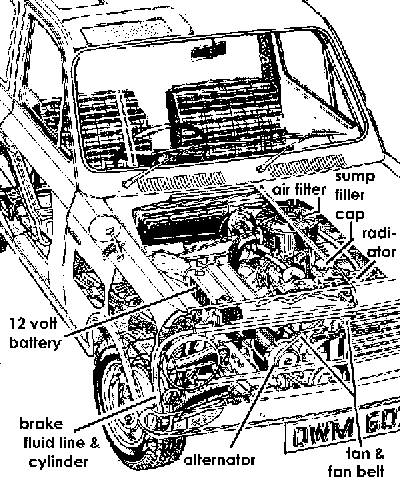 Heavy goods vehicles (HGVs) are a different matter. In many cases although the cab itself may be alarmed, the way the vehicle is built makes vulnerable parts easier to get hold of. In particular the fuel and electrical systems, and the engine/power train, can be easily reached by clambering underneath. Unlike cars, where cutting the brakes means the car can't stop, with many HGV the airbrake systems means that if the air isn't there you can get the brakes off - this makes them an obvious target. Basic layout of heavy goods vehicles (figures 23/24)
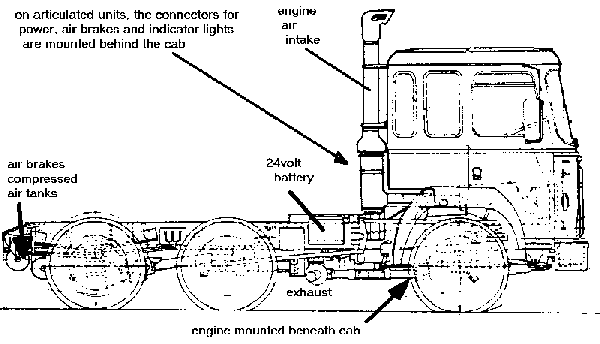
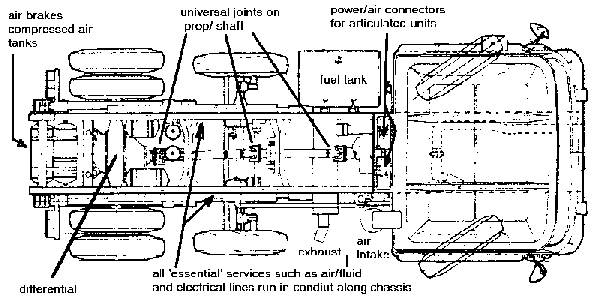 Earth movers, JCBs and dumpers are more difficult. This is not only because they are more enclosed than HGVs, but the components are generally made to withstand greater damage. Unless you can get the body panels off you only options are to go for the accessible parts of the hydraulic system, the fuel tank filler pipe, the cab (if it is not alarmed) and the tyres/tracks. Example of typical earth mover (figures 25/26)
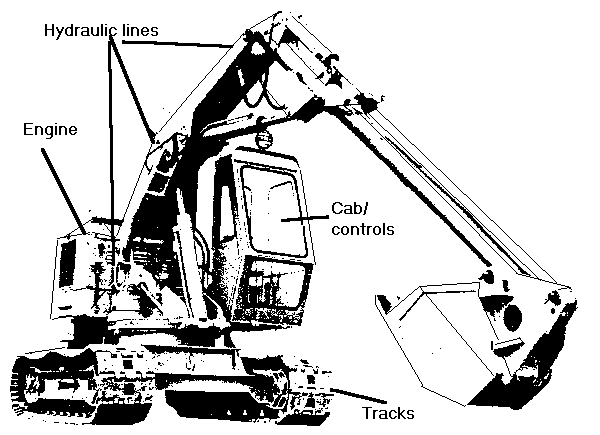
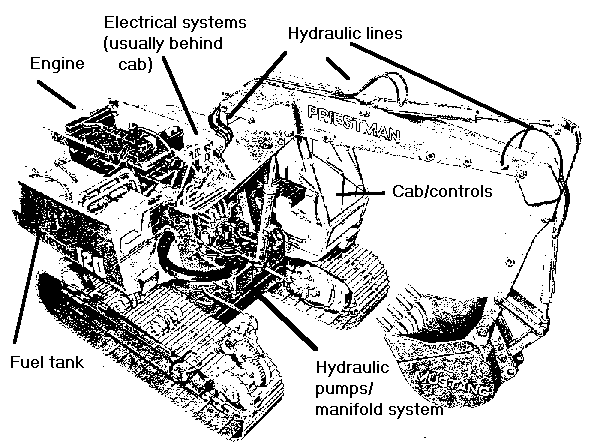 8.2 General sabotage optionsWhen first approaching a vehicle you need to consider three things... In general you should assume that any locked vehicle is alarmed - but if you have planned the hit to allow for activating the alarm without attracting attention then that's OK. HGVs present the most fruitful target when alarmed, but cars do not because the vibration sensors will detect and sharp banging. The simplest option with cars is to drill the tyres - this makes very little vibration, and they go down fairly slowly so that the rim of the wheel doesn't land with a jolt. The issue of accessible parts is also important. If you are able to sugar the fuel, irrespective of anything else, you can consider the job done. But to be sure you really need to do some work on other parts of the vehicle. The hydraulics is the obvious choice on earth movers, and the electrical/air systems are the obvious choice on HGVs. With cars, if you are very gentle, you may be able to get underneath and crush the fuel line closed, or reach up from underneath into the engine cavity and cut some wires. Finally, if you have a choice between a car, and an HGV next to it, it is obvious which you do first - the HGV has more accessible parts. Likewise if you had a pound full of cars which were covered in alarms, but the security gate had an number of strong locks on it, you would glue up the locks on the security gate. Whatever tactic you apply, you should still use the energy flow analysis of the system to target the parts of the vehicle it would be most effective to sabotage. 8.3 Engine and fuel systemsThe fuel tank on most cars is located at the rear, underneath the boot. A metal pipe then runs from the tank, underneath the chassis to the fuel pump mounted on the engine block. Draining or cutting this system will deprive the engine of fuel. If you wished to take the drastic action of setting fire to the car, you could also cut/drill this system to provide the fuel to start the fire. If you ever need to syphon fuel from a vehicle, cutting the fuel pipe or making a hole in the tank is also quicker and safer than trying to chisel off a locked petrol cap. But beware - draining fuel tanks can cause a lot of pollution, unless you catch the fuel in a can or tray. These same rules apply to HGVs - the only thing is that diesel is less volatile, and consequently harder to set fire to. The easiest way is to pile some paper and wood in a heap, put diesel on the paper, and then set fire to the 'dry' pieces of paper. Engines are difficult to get at because they are locked under bonnets, or in the case of the HGV, you often have to hinge open the whole cab. The options are therefore limited. You could drain the oil by taking out the sump plug, but this will show up when the engine is started, and draining the oil, especially from HGVs, can cause a lot of pollution. If you can get the bonnet open, you should first go for the spark plugs, or on diesel engines, the injectors (see diagrams earlier). If you want to make a really good job, find the oil filler cap, or the dip stick hole, and try getting some abrasive material into the engine (see the 'abrasives' section of volume I). Grinding/polishing powder is best (because its hard) but sand will do as a substitute. 8.4 Brakes and hydraulic systemsYou should never cut fluid brake systems on cars or vans. This is because all power to the brakes will be lost. Air brake systems on HGVs can be cut - but carefully so that you don't injure yourself - because the brakes are held off by air pressure, and cutting the pipes means the brakes won't come off. Hydraulic systems are a problem, partly because of the dangers of the equipment moving/collapsing. There is also the matter of pollution arising from the leaking hydraulic fluid. Choosing which pipes to cut is a matter of what you tooling capability is. If you have good bolt cutters then hoses up to 1" diameter, and pipes up to 0.5" should present little problem. Where bigger pipes are involved, you should consider drilling them with a small (2mm) drill bit. If the parts are accessible, it is more effective to go for the manifolds and valves - they are more expensive and take longer to replace. To rally damage the hydraulic rams you need a power drill and a specially hardened drill bit suitable for cutting hardened steel. 8.5 Electrical systemsIf the vehicle is switched off, then apart from the leads coming from the battery to the solenoid, and the lighting system, the wires should have no power running through them. Even so, apart from the battery leads, cutting other cables will have little effect because any short circuit will involve low voltages, and the fuses should blow. It can be difficult to identify specific parts of the electrical system, except for the simple things like the distributor cap/plug leads, and battery leads. In general it is often easier to just cut everything quickly. Also, rather then cutting a cable once, try to cut one or two inch sections from the cable - this means they have to be replaced rather then just joined back together.
[Back to Contents]
[Go to next section]mailto:webmistress@sabotage.org goto:webmistress |